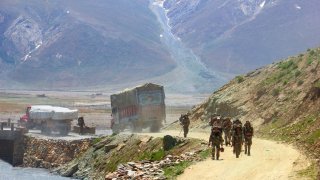India’s China Challenge
Decoding China’s intentions in its border dispute with India remains an intractable puzzle for New Delhi’s strategists.
At the same time, Pakistan may activate the Line of Control and incite terror incidents in Kashmir and communal violence in India as a diversion tactic and facilitate the execution of Beijing’s game plan as swiftly as possible. In another scenario, China may continue embarrassing and pressuring India with its periodic salami-slicing incursions. Coupled with such military adventures, India may have to face cyber-attacks on its critical infrastructure, military and civil installations, financial institutions, and stock markets.
An invasion may happen where India least expects it. Though most recent incursions and encroachment have taken place in the Ladakh region, New Delhi cannot assume that an attack can only occur in the western sector. Minor and periodic Chinese incursions could act as diversion tactics to hide the real game plan of a mid-sized invasion in the eastern sector of the India-China border, Arunachal Pradesh, which Beijing claims as “South Tibet.” To add more to the prevailing confusion, China may initiate incursions in the middle sector, encourage Nepal to be more aggressive on the Indian border and claim Kalapani, and create intense pressure in Bhutan either by deployment, increased patrols in disputed areas, or by infrastructure build-up.
Reportedly, the Chinese may believe this middle path of swift and mid-sized invasion is feasible in terms of a cost-benefit analysis. First, the invasion will likely be very swift, giving minimum response time to the Indian side. Against the backdrop of existing uncertainty and ambiguity, by the time New Delhi realizes Beijing’s intent, the PLA would have secured most of its intended outcomes. Second, Indian communications and road infrastructure in the Himalayan region are developing fast; however, there is a long way to go before they catch up with China.
I have discussed in a previous article that China has constructed a sophisticated network of axial roads in the border areas, which makes troop and equipment movement much easier and rapid vis-à-vis movement on the Indian side. In such a scenario, Americans can help only by providing intelligence, minor communications equipment, and technological support, enabling smooth logistics. They are unlikely to put their boots on the ground. Political will aside, the Himalayan terrain is harsh, and the American soldiers are not accustomed to it.
The battles in the Himalayan region are likely to be infantry and artillery-centric, in which the road infrastructure will play a critical role, and China has a clear short-term advantage on that front. Additionally, China can utilize its drones and rocket force. Lastly, in such a scenario, India’s relationship with Russia would be of little value once a conflict erupts. Due to Moscow’s increased dependence on Beijing after the Ukraine war, its capabilities are limited. By the time they can influence Chinese policymakers, Beijing will have secured its gains, after which the world powers will intervene, urging restraint and diplomacy.
The chances of such a swift, embarrassing, and destabilizing attack and the periodic accidental or deliberate skirmishes escalating into a full-fledged conventional war are minimal at this stage. If the conflict escalates beyond a point and gets longer, China will be embroiled in a long-drawn and protracted conflict in rugged Himalayan terrain. India has also come a long way from where it was in 1962. Today, India is a nuclear power and a leader in advanced space programs. In addition to its robust scientific, technological, and industrial base with the fourth largest military and fifth largest GDP, it has a much stronger and credible standing in global geopolitics. Hence, if it can neutralize the initial brunt of a Chinese attack, Indians could give a robust defense and counterattack, bringing massive embarrassment to China.
Such a scenario will be a major setback to China’s long-term ambitions to become a world power and contend with the United States. Also, following such a scenario, India would likely abandon its neutrality and switch to the American side, get closer to Quad countries and the Western camp, and cause hurdles for China’s supply lines in the Malacca straits with its strong naval presence in the Indian Ocean. It can reject the “One China” theory in principle, take a strong anti-China stand by joining forces with Vietnam, Japan, Philippines, and Indonesia, and in theatres like the Middle East, Afghanistan, and the South Caucasus, where it has emerged with a robust strategic footprint. Also, it can be more active with the Quad countries in the South China Sea and East China Sea.
Dr. Abhinav Pandya is a founder and CEO of Usanas Foundation, an India-based geopolitical and security affairs think-tank, and the author of Radicalization in India: An Exploration and Terror Financing in Kashmir. He has a Ph.D. from OP Jindal University and an MPA from Cornell University.
Image: Natalia Davidovich / Shutterstock.com.

